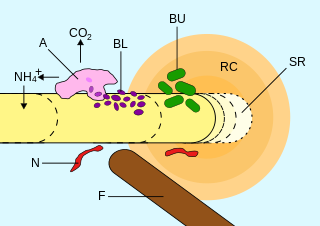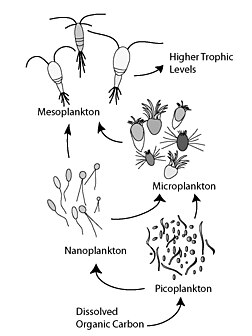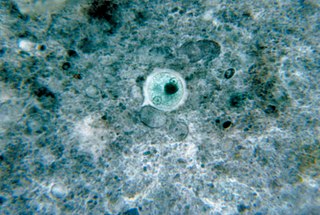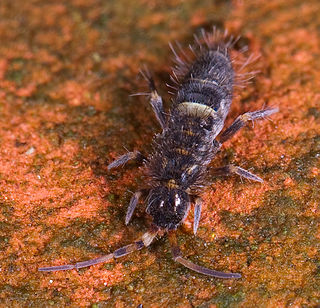Related Research Articles

An ecosystem is a community of living organisms in conjunction with the nonliving components of their environment, interacting as a system. These biotic and abiotic components are linked together through nutrient cycles and energy flows. Energy enters the system through photosynthesis and is incorporated into plant tissue. By feeding on plants and on one another, animals play an important role in the movement of matter and energy through the system. They also influence the quantity of plant and microbial biomass present. By breaking down dead organic matter, decomposers release carbon back to the atmosphere and facilitate nutrient cycling by converting nutrients stored in dead biomass back to a form that can be readily used by plants and other microbes.

A microorganism, or microbe, is a microscopic organism, which may exist in its single-celled form or in a colony of cells.

Fauna is all of the animal life present in a particular region or time. The corresponding term for plants is flora. Flora, fauna and other forms of life such as fungi are collectively referred to as biota. Zoologists and paleontologists use fauna to refer to a typical collection of animals found in a specific time or place, e.g. the "Sonoran Desert fauna" or the "Burgess Shale fauna". Paleontologists sometimes refer to a sequence of faunal stages, which is a series of rocks all containing similar fossils. The study of animals of a particular region is called faunistics.
Organic matter, organic material, or natural organic matter refers to the large source of carbon-based compounds found within natural and engineered, terrestrial and aquatic environments. It is matter composed of organic compounds that have come from the remains of organisms such as plants and animals and their waste products in the environment. Organic molecules can also be made by chemical reactions that don't involve life. Basic structures are created from cellulose, tannin, cutin, and lignin, along with other various proteins, lipids, and carbohydrates. Organic matter is very important in the movement of nutrients in the environment and plays a role in water retention on the surface of the planet.

The soil food web is the community of organisms living all or part of their lives in the soil. It describes a complex living system in the soil and how it interacts with the environment, plants, and animals.

The rhizosphere is the narrow region of soil that is directly influenced by root secretions and associated soil microorganisms known as the root microbiome. The rhizosphere contains many bacteria and other microorganisms that feed on sloughed-off plant cells, termed rhizodeposition, and the proteins and sugars released by roots. This symbiosis leads to more complex interactions, influencing plant growth and competition for resources. Much of the nutrient cycling and disease suppression needed by plants occurs immediately adjacent to roots due to root exudants and communities of microorganisms. The rhizosphere also provides space to produce allelochemicals to control neighbours and relatives. The plant-soil feedback loop and other physical factors are important selective pressures for the communities and growth in the rhizosphere.

Entomopathogenic nematodes are a group of nematodes, causing death to insects. The term entomopathogenic has a Greek origin, with entomon, meaning insect, and pathogenic, which means causing disease. They are animals that occupy a bio control middle ground between microbial pathogens and predator/parasitoids, and are habitually grouped with pathogens, most likely because of their symbiotic relationship with bacteria. Although many other parasitic thread worms cause diseases in living organisms, entomopathogenic nematodes, are specific in only infecting insects. Entomopathogenic nematodes (EPNs) live parasitically inside the infected insect host, and so they are termed as endoparasitic. They infect many different types of insects living in the soil like the larval forms of moths, butterflies, flies and beetles as well as adult forms of beetles, grasshoppers and crickets. EPNs have been found in all over the world and a range of ecologically diverse habitats. They are highly diverse, complex and specialized. The most commonly studied entomopathogenic nematodes are those that can be used in the biological control of harmful insects, the members of Steinernematidae and Heterorhabditidae. They are the only insect-parasitic nematodes possessing an optimal balance of biological control attributes..

Soil biology is the study of microbial and faunal activity and ecology in soil. Soil life, soil biota, soil fauna, or edaphon is a collective term that encompasses all organisms that spend a significant portion of their life cycle within a soil profile, or at the soil-litter interface. These organisms include earthworms, nematodes, protozoa, fungi, bacteria, different arthropods, as well as some reptiles, and species of burrowing mammals like gophers, moles and prairie dogs. Soil biology plays a vital role in determining many soil characteristics. The decomposition of organic matter by soil organisms has an immense influence on soil fertility, plant growth, soil structure, and carbon storage. As a relatively new science, much remains unknown about soil biology and its effect on soil ecosystems.
Soil ecology is the study of the interactions among soil biology, and between biotic and abiotic aspects of the soil environment. It is particularly concerned with the cycling of nutrients, formation and stabilization of the pore structure, the spread and vitality of pathogens, and the biodiversity of this rich biological community.
Bacteria are economically important as these microorganisms are used by humans for many purposes. The beneficial uses of bacteria include the production of traditional foods such as yogurt, cheese, and vinegar. Microbes are also important in agriculture for the compost and fertilizer production.

The microbial loop describes a trophic pathway in the marine microbial food web where dissolved organic carbon (DOC) is returned to higher trophic levels via its incorporation into bacterial biomass, and then coupled with the classic food chain formed by phytoplankton-zooplankton-nekton. The term microbial loop was coined by Farooq Azam and Tom Fenchel et al. to include the role played by bacteria in the carbon and nutrient cycles of the marine environment.
The microbial food web refers to the combined trophic interactions among microbes in aquatic environments. These microbes include viruses, bacteria, algae, heterotrophic protists.

A microbial cyst is a resting or dormant stage of a microorganism, usually a bacterium or a protist or rarely an invertebrate animal, that helps the organism to survive in unfavorable environmental conditions. It can be thought of as a state of suspended animation in which the metabolic processes of the cell are slowed and the cell ceases all activities like feeding and locomotion. Encystment, the formation of the cyst, also helps the microbe to disperse easily, from one host to another or to a more favorable environment. When the encysted microbe reaches an environment favorable to its growth and survival, the cyst wall breaks down by a process known as excystation. In excystment, the exact stimulus is unknown for most protists.

A microbial mat is a multi-layered sheet of microorganisms, mainly bacteria and archaea. Microbial mats grow at interfaces between different types of material, mostly on submerged or moist surfaces, but a few survive in deserts. They colonize environments ranging in temperature from –40 °C to 120 °C. A few are found as endosymbionts of animals.

The nematodes or roundworms constitute the phylum Nematoda, with plant-parasitic nematodes being known as eelworms. They are a diverse animal phylum inhabiting a broad range of environments. Taxonomically, they are classified along with insects and other moulting animals in the clade Ecdysozoa, and unlike flatworms, have tubular digestive systems with openings at both ends. Like tardigrades they have a reduced number of Hox genes, but as their sister phylum Nematomorpha has kept the ancestral protostome Hox genotype, it shows that the reduction has occurred within the nematode phylum.

Microbiology is the study of microorganisms, those being unicellular, multicellular, or acellular. Microbiology encompasses numerous sub-disciplines including virology, bacteriology, protistology, mycology, immunology and parasitology.

Springtails (Collembola) form the largest of the three lineages of modern hexapods that are no longer considered insects. Although the three orders are sometimes grouped together in a class called Entognatha because they have internal mouthparts, they do not appear to be any more closely related to one another than they are to all insects, which have external mouthparts.
The Phytobiome is a term that relates to a plant (phyto) in a specific ecological area (biome). It includes the plant itself, the environment and all micro- and macro-organisms living in, on, or around the plant. These organisms include bacteria, archaea, fungi, protists, insects, animals and other plants. The environment includes the soil, air and climate. Examples of ecological areas are fields, rangelands, forests. Knowledge of the interactions within a phytobiome can be used to create tools for agriculture, crop management, increased health, preservation, productivity, and sustainability of cropping and forest systems.

The branches of microbiology can be classified into pure and applied sciences. Microbiology can be also classified based on taxonomy, in the cases of bacteriology, mycology, protozoology, and phycology. There is considerable overlap between the specific branches of microbiology with each other and with other disciplines, and certain aspects of these branches can extend beyond the traditional scope of microbiology In general the field of microbiology can be divided in the more fundamental branch and the applied microbiology (biotechnology). In the more fundamental field the organisms are studied as the subject itself on a deeper (theoretical) level. Applied microbiology refers to the fields where the micro-organisms are applied in certain processes such as brewing or fermentation. The organisms itself are often not studied as such, but applied to sustain certain processes.
Stilbonematinae is a subfamily of the nematode worm family Desmodoridae that is notable for its symbiosis with sulfur-oxidizing bacteria.
References
- ↑ Effects of microbivore species composition and basal resource enrichment on trophic-level biomasses in an experimental microbial-based soil food web. J Mikola, Oecologia, 1998
- ↑ Rates of metazoan meiofaunal microbivory: a review. PA Montagna, Vie et Milieu, 1995
- ↑ Energetics of detritivory and microbivory in soil in theory and practice. DC Coleman, Food Webs, 1996
- ↑ Radioisotope technique to quantify in situ microbivory by meiofauna in sediments. PA Montagna, Handbook of methods in aquatic microbial ecology …, 1993
- ↑ Life cycle of the microbivorous Antarctic Dry Valley nematode Scottnema lindsayae (Timm 1971). A Overhoff, DW Freckman, RA Virginia - Polar Biology, 1993
- ↑ Organic and inorganic nitrogenous losses by microbivorous nematodes in soil. RV Anderson, WD Gould, LE Woods, C Cambardella… - Oikos, 1983
- ↑ Uncoupling of carbon and nitrogen mineralization: role of microbivorous nematodes. MC Savin, JH Görres, DA Neher, JA Amador - Soil Biology and Biochemistry, 2001
- ↑ Robert A. Freitas Jr., Microbivores: Artificial Mechanical Phagocytes using Digest and Discharge Protocol, self-published, 2001
